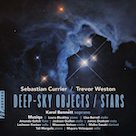

Sebastian Currier / Trevor Weston: Deep-Sky Objects / Stars
Navona Records
The Sebastian Currier and Trevor Weston works performed by the Houston-based chamber ensemble Musiqa and soprano Karol Bennett on this stimulating release are startlingly complementary. Casting their gazes skyward, both Deep-Sky Objects and Stars are multi-movement meditations that reflect on outer space in different ways. With poetic texts by Sarah Manguso and electronic treatments woven into its design, Currier's Deep-Sky Objects updates the Romantic song cycle tradition by giving it an intergalactic context. Weston's Stars, on the other hand, utilizes lyrics by Robert Hayden to reflect on the night sky and its impact on humanity through the ages.
Led by Artistic Director Anthony Brandt, Musiqa delivers sterling readings of the works, which doesn't surprise when both were commissioned by the forward-thinking company. Founded in 2002, the ensemble is a flexible unit that adapts itself to the work at hand, and consistent with that five different Musiqa members appear on each work with no personnel overlapping. Needless to say, a key connecting thread on the release is Bennett when her luminous voice and versatile delivery are front and centre throughout. Musiqa's commitment extends far beyond this release as the ensemble has presented works by nearly 300 living composers and commissioned close to 100 new works. The outfit also embraces the possibilities afforded by multi-disciplinary projects and has collaborated with countless dancers, actors, poets, and filmmakers during its tenure. Houston should be proud of what the company has achieved and the integrity it's shown in its commitment to new music and innovative programming.
Currier has created works for solo, chamber and orchestral genres, including his admired violin concerto Time Machines, which was commissioned by Anne-Sophie Mutter and premiered by the New York Philharmonic in June 2011. Deep-Sky Objects stands out for its audacious merging of acoustic and electronic elements. For the work's texts, he set music to words created specifically for it by Manguso, an award-winning writer whose ten books encompass stories, poetry, and non-fiction. Described by the composer as “a cycle of love songs set in the distant future, exploring intergalactic longing and desire,” Deep-Sky Objects blends soprano and piano quintet with pre-recorded electronic sounds across ten concise movements. In simplest terms, the work imagines a woman pining for a lover who is far away on a remote planet. Despite the distance between them, she's empowered by the simple fact of his existence: “I can live in the world / with your love / because I know you exist / at the end of the black universe.” The electronic elements simulate alien, R2D2-like sounds emanating from pulsars, satellites, and other distant sources.
After jittery squiggles initiate the work in “Satellite,” Bennett and the quintet enter to bring their own urgency to the performance. While the less intense “Clouds” infuses the piece with a dream-like austerity, the spaciousness of the music alludes to the vastness of space and the physical separation between the lovers; the delicate atmospheric swirl that backs Bennett during “Light” also amplifies the enigmatic character of the writing. Each movement is initiated by electronic effects that set the tone, such that “Storm” sees violent clatter followed by a kindred kind of agitation in the acoustic component. With piano plinking alongside the singer and strings, “Belief” and “Duet” even take on a rather Messiaen-like quality (think Turangalîla-Symphonie). Some parts of this arresting piece are tempestuous (“Want”) and others serene (“Time”), but all are daring and adventurous in their own way.
Music by Weston, who's a Professor of Music and Chair of the Music Department at Drew University in Madison, New Jersey, has been recorded by JACK Quartet, Ensemble Pi, and violinist Dan Flanagan and performed by a large number of ensembles, including The San Francisco Symphony, The Bang on a Can All-Stars, New York Philharmonic, Roomful of Teeth, and others. For the text of Stars, Weston turned to Hayden (1913–80), a renowned African-American poet, essayist, and educator. Discovering that his poem “Stars” gave voice to his own fascination with stars, Weston set about composing movements based on the five sections of the poem and scoring the work for soprano, flute, clarinet, violin, cello, and piano.
The opening movement, simply marked “I,” establishes the work's galaxial scope in setting its ascendant sights on the constellation Orion. A similar sense of yearning infuses the second movement, which sees restrained passages offset by ones of greater urgency and activity. The blues-tinged “III (Sojourner Truth),” on the other hand, honours the African American abolitionist and feminist who took a bold stance against injustice by walking away from slavery. Casting its gaze in a totally different direction, the enigmatic “IV” musically envisions pulsars as static harmonies over which Bennett reflectively muses. She leads the instruments in the fifth movement, the gesture intended to parallel the fact that the stars we see are technically in the past given the time it takes for their image to reach us.
Unlike Currier's, Weston's work eschews electronics, but in its tone it's no less unusual and ethereal. In appearing in every one of the works' respective movements, Bennett becomes the key humanizing force on the album, though Musiqa isn't far behind. Certainly the composers are fortunate to have had such enthusiastic and committed performers as their partners for this dynamic and unusual recording project.June 2025